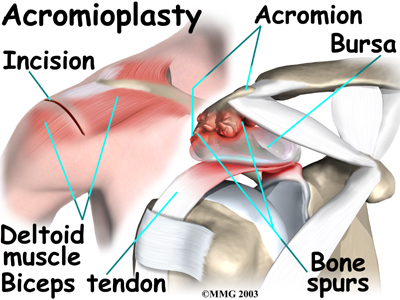A bony growth that appears on a normal bone is referred to as a bone spur or osteophyte. You may think that a spur is sharp but it is actually just an extra bone. A bone spur is usually smooth, but it may cause pain or wear and tear if it rubs or presses on other structures such as bones or soft tissues including tendons, nerves or ligaments in the body. The common places in which bone spurs occur are shoulders, spine, hips, hands, knees and feet.
What Cause Bone Spurs in Shoulders?
Typically bone spurs in your shoulder occur due to continued stress or rubbing of a bone on another for long periods of time. The cause of this can be osteoarthritis or inflammation due to tendinitis. A normal joint has a layer of cartilage on the surface of the bones forming the joint. In osteoarthritis, this cartilage layer is destroyed due to wear and tear causing the bones to rub against each other directly. Due to this stress or inflammation, new bone forms and this is the method of bone to try to protect and stabilize itself.
What Does Bone Spurs in Shoulder Feel like?
Usually there are no symptoms or signs associated with bone spur. You may not realize that you have a bone spur, until it is found on an X-ray done for another medical condition. However, in some cases, it may lead to symptoms of pain and loss of joint motion. Some of the signs and symptoms may include:

1. Shoulder Pain
Pain is the most common symptom of bone spurs in shoulders. The pain can be described as achy and dull, but it may become sharp with shoulder joint movements and be relieved with rest. If this pain worsens during a period of inactivity, it must be caused by osteoarthritis because the spurs may compress the nearby sensory nerves located in the muscle, bone and soft tissues of the shoulder joint. Pain signals are sent to the brain by these sensory nerves.
2. Shoulder Swelling
Swelling in shoulder occurs because rubbing of bones makes the body’s immune system release certain chemicals, which cause swelling of tissues. One shoulder may appear larger than the other, and may become red and warm to touch.
3. Limited Shoulder Motion
The patient with bone spurs in shoulder may experience limited shoulder motion. The bone spur impinges on the rotator cuff or rub on other bones, limiting the motion of shoulders. In addition, the mobility of shoulder can also be significantly reduced by the swelling.
Hence, if there is a problem with increased pain in your shoulder joint or loss of motion of shoulder joint, then you may be having bone spurs in your shoulder. However, these symptoms may also be caused by other conditions. If you have shoulder pain that becomes intolerable, it is advised that you see a doctor and have your shoulder evaluated.
How to Treat Bone Spurs in Shoulder
Treatment depends upon symptoms and the following methods may be used in combination to treat the condition:
1. Medications
The initial treatment of pain and inflammation begins with medicines. Over the counter anti-inflammatory medicines may be used to reduce both the pain and inflammation caused by bone spurs. In some cases, steroid such as cortisone may be injected into the joint.
2. Physical Therapy
Physical therapy may be recommended by doctors to relieve symptoms of bone spurs in shoulders. Though the bone spurs are not removed, physical therapy can improve the loss of motion in shoulder joints by strengthening the surrounding muscles. Physical therapy includes cold or ice packs, ultrasound treatments, stretching exercises and massage.
3. Surgery
Surgery is an option in cases where the symptoms are not relieved with conservative treatments. The main aim of surgical treatment is to remove the extra bone and remove the pressure caused by the spurs on the surrounding muscles, ligaments, tendons and nerves. Surgery may be done to only remove the spur or may form a part of a bigger surgery such as a replacement of joint. If the problem due to bone spurs in shoulder continues or worsens, it is recommended to follow up with a physician and get the problem evaluated further.
4. Prevention
Since bone spurs in shoulder are due to arthritis, there is no specific method for their prevention. Remaining physically fit and leading an active lifestyle can help decrease the symptoms due to bone spurs.
